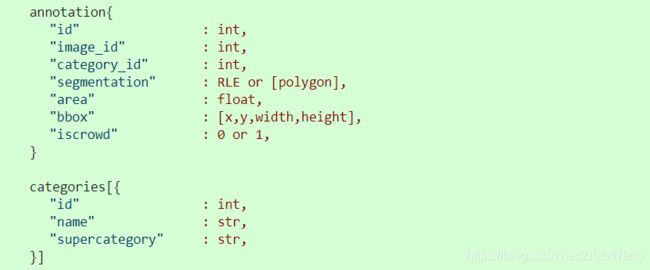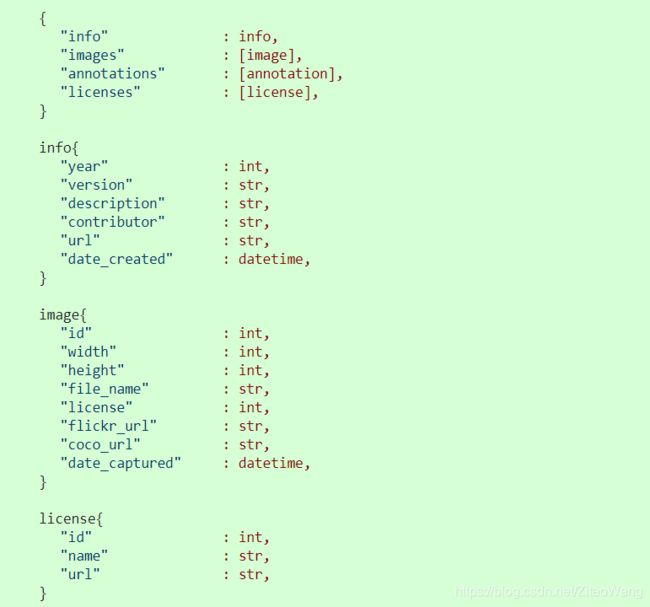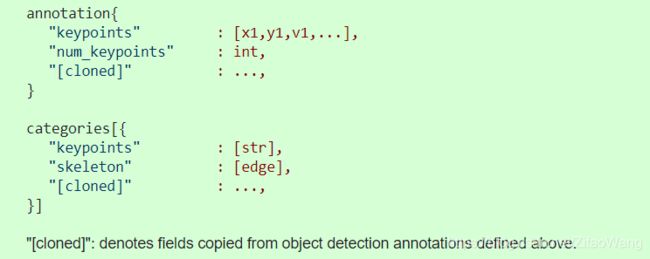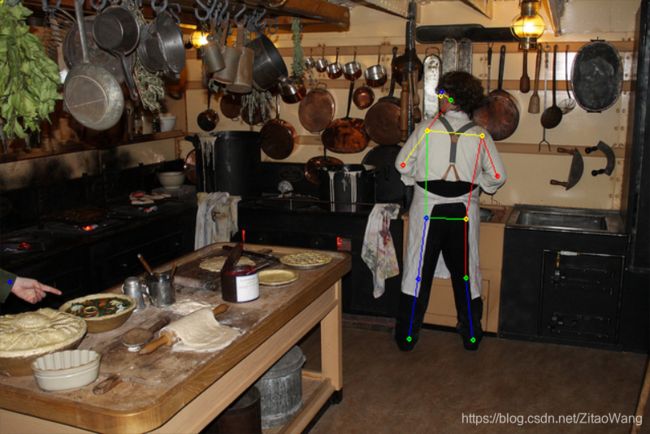COCO数据集annotations解析以及可视化
针对数据集cocoval2017,解析其annotations文件夹下person_keypoints_val2017.json文件构成以及可视化。
目录
一、person_keypoints_val2017.json的结构分析
1. “info”
2. "licenses"
3. "categories"
4. "images": list of dictionary
5. ”annotations": list o dictionary
二、将整个json文件进行拆分,分出单个图像以及其对应的标注文件以进行后续的可视化
三、json文件可视化
1. 利用COCO API
1.1 加载对应img_id/cat_id的照片并可视化
1.2 加载对应照片的annotation并可视化
1.3 加载对应照片语义分析数据并打印
2. 用openCV可视化
一、person_keypoints_val2017.json的结构分析
根据coco官网给出的data format信息(https://cocodataset.org/#format-data),总体结构如下图所示:
对于任务object detection:若检测到的是单个物体,iscrowd=0,segmentation mask为[polygon]的格式,即多边形顶点的坐标,但由于单个物体可能会被遮挡,有时候需要多个polygon来表示;若检测到是多个物体的集合体(例如一群人),iscrowd=1,则采用RLE编码的格式。categories部分存储了categories_id到categories的mapping。
 对于任务keypoints detection,在object detection的基础上增加了keypoints和num_keypoints,每个关键点都有一个可见性标志 v,v=0:未标记(在这种情况下 x=y=0),v=1:标记但不可见,v=2:标记并且可见。skeleton定义了各个关键点之间的连接性。
对于任务keypoints detection,在object detection的基础上增加了keypoints和num_keypoints,每个关键点都有一个可见性标志 v,v=0:未标记(在这种情况下 x=y=0),v=1:标记但不可见,v=2:标记并且可见。skeleton定义了各个关键点之间的连接性。
1. “info”
"info": {
"description": "COCO 2017 Dataset",
"url": "http://cocodataset.org",
"version": "1.0",
"year": 2017,
"contributor": "COCO Consortium",
"date_created": "2017/09/01"
},
2. "licenses"
"licenses": [
{
"url": "http://creativecommons.org/licenses/by-nc-sa/2.0/",
"id": 1,
"name": "Attribution-NonCommercial-ShareAlike License"
},
{
"url": "http://creativecommons.org/licenses/by-nc/2.0/",
"id": 2,
"name": "Attribution-NonCommercial License"
},
# 这里仅列举两个
]
3. "categories"
"categories": [
{
"supercategory": "person",
"id": 1,
"name": "person",
"keypoints": [
"nose",
"left_eye",
"right_eye",
"left_ear",
"right_ear",
"left_shoulder",
"right_shoulder",
"left_elbow",
"right_elbow",
"left_wrist",
"right_wrist",
"left_hip",
"right_hip",
"left_knee",
"right_knee",
"left_ankle",
"right_ankle"
],
"skeleton": [[16,14],[14,12],[17,15],[15,13],[12,13],[6,12],[7,13],[6,7],[6,8],[7,9],[8,10],[9,11],[2,3],[1,2],[1,3],[2,4],[3,5],[4,6],[5,7]]
}
]
上述1、2、3是全局通用的
4. "images": list of dictionary
"images": [
{
"license": 4,
"file_name": "000000397133.jpg",
"coco_url": "http://images.cocodataset.org/val2017/000000397133.jpg",
"height": 427,
"width": 640,
"date_captured": "2013-11-14 17:02:52",
"flickr_url": "http://farm7.staticflickr.com/6116/6255196340_da26cf2c9e_z.jpg",
"id": 397133
}
]
5. ”annotations": list o dictionary
"annotations": [
{
"segmentation": [
[
446.71,
70.66,
466.07,
72.89,
......
]
],
"num_keypoints": 13,
"area": 17376.91885,
"iscrowd": 0,
"keypoints": [
433,
94,
2,
434,
90,
2,
0,
0,
0,
...
],
"image_id": 397133,
"bbox": [
388.66,
69.92,
109.41,
277.62
],
"category_id": 1,
"id": 200887
},
#这里只列出一个object的ann信息
]
二、将整个json文件进行拆分,分出单个图像以及其对应的标注文件以进行后续的可视化
# -*- coding:utf-8 -*-
import json
json_file = r"path\to\person_keypoints_val2017.json"
data = json.load(open(json_file, 'r'))
data_2 = {
'info': data['info'],
'categories': data['categories'],
'licenses': data['licenses'],
'images': [data['images'][0]]
}
annotation = []
imgID = data_2['images'][0]['id']
for ann in data['annotations']:
if ann['image_id'] == imgID:
annotation.append(ann)
data_2['annotations'] = annotation
json.dump(data_2, open(r'path\to\single_person_kp.json', 'w'), indent=4)三、json文件可视化
1. 利用COCO API
1.1 加载对应img_id/cat_id的照片并可视化
# -*- coding:utf-8 -*-
import os
from pycocotools.coco import COCO
import skimage.io as io
import matplotlib.pyplot as plt
import pylab
pylab.rcParams['figure.figsize'] = (8.0, 10.0)
annFile = r'path\to\COCO\COCO2017\annotations\person_keypoints_val2017.json'
coco = COCO(annFile) # COCO的初始化,读入相应的ann文件
# display COCO categories and supercategories
# coco.getCatIds()返回的是ann文件中list of所有的["categories"]["id"]
# coco.loadCats()返回的是list of对应所有id的categories(即又回到了ann文件中的字典形式)
cats = coco.loadCats(coco.getCatIds())
nms = [cat['name'] for cat in cats] # 提取各个字典中的name
print('COCO categories: \n{}\n'.format(' '.join(nms)))
nms = set([cat['supercategory'] for cat in cats]) # 提取各个字典中的supercategory
print('COCO supercategories: \n{}'.format(' '.join(nms)))
# COCO categories:
# person
# COCO supercategories:
# person
# loadImgs()返回值是单元素列表,用[0]调用,img其元素为字典,key为"license", "file_name", "coco_url", "height", "width", "date_captured", "id"
# 加载指定id照片,两种途径:
# 1)本地图片,img["file_name"]
# 2)远程图片,img["coco_url"] --> I = io.imread(img["coco_url"])
imgIds = coco.getImgIds(imgIds=[397133]) # 给定参数img_id和cat_id,返回list of对应的所有img_id和包含了指定cat_id的所有img_id
img = coco.loadImgs(imgIds)[0] # loadImgs()返回list of给出id的image,为ann文件中的字典形式,这里用[0]调取列表中第一张img信息
img_path = os.path.join(r"path\to\COCO\COCO2017\val2017", img["file_name"])
I = io.imread(img_path)
# I = io.imread(img["coco_url"])
plt.axis('off');plt.imshow(I);plt.show()1.2 加载对应照片的annotation并可视化
# 加载指定index的照片和该照片内包含的所有类别的物体并且可视化标注
catIds = []
for ann in coco.dataset['annotations']:
if ann['image_id'] == imgIds[0]:
catIds.append(ann['category_id']) # 把该照片包含的所有的物体的cat_id都提取出来
plt.imshow(I); plt.axis('off')
annIds = coco.getAnnIds(imgIds=img['id'], catIds=catIds, iscrowd=None)
anns = coco.loadAnns(annIds)
coco.showAnns(anns)
# print(img['id']==imgIds[0]) --> true
plt.show()1.3 加载对应照片语义分析数据并打印
# 加载并打印该照片包含的语义分析数据
annFile = r"E:\Datasets\COCO\COCO2017\annotations\captions_val2017.json"
coco_caps = COCO(annFile)
annIds = coco_caps.getAnnIds(imgIds=img['id'])
anns = coco_caps.loadAnns(annIds)
coco_caps.showAnns(anns)
# plt.imshow(I)
# plt.axis('off'); plt.show()输出:
loading annotations into memory...
Done (t=0.10s)
creating index...
index created!
A man is in a kitchen making pizzas.
Man in apron standing on front of oven with pans and bakeware
A baker is working in the kitchen rolling dough.
A person standing by a stove in a kitchen.
A table with pies being made and a person standing near a wall with pots and pans hanging on the wall.
2. 用openCV可视化
# -*- coding:utf-8 -*-
import numpy as np
from pycocotools.coco import COCO
import cv2
annFile = r'E:\Datasets\COCO\COCO2017\annotations\person_keypoints_val2017.json'
img_prefix = r'E:\Datasets\COCO\COCO2017\val2017'
aColor = [(0, 255, 0, 0), (255, 0, 0, 0), (0, 0, 255, 0), (0, 255, 255, 0)]
coco = COCO(annFile)
# getCatIds(catNms=[], supNms=[], catIds=[])
# 通过输入类别的名字、大类的名字或是类别的id,来筛选得到图片所属类别的id
catIds = coco.getCatIds(catNms=['person']) # 1
# getImgIds(imgIds=[], catIds=catIds)
# 通过图片的id或是所属种类的id得到图片的id
# 得到图片的id信息后,就可以用loadImgs得到图片的信息了
# 这里选取imgIds = 397133这张照片进行可视化
imgIds = 397133
img = coco.loadImgs(imgIds)[0]
matImg = cv2.imread('%s/%s' % (img_prefix, img['file_name']))
annIds = coco.getAnnIds(imgIds=img['id'], catIds=catIds, iscrowd=None)
# 通过注释的id,得到注释的信息
anns = coco.loadAnns(annIds)
print(ann['id'] for ann in anns) # 核实一下是不是200887 1218137
for ann in anns:
sks = np.array(coco.loadCats(ann['category_id'])[0]['skeleton']) - 1
# 把skeleton里的坐标值转换成0开始的index
kp = np.array(ann['keypoints'])
x = kp[0::3]
y = kp[1::3]
v = kp[2::3]
for sk in sks:
# c = (np.random.random((1, 3)) * 0.6 + 0.4).tolist()[0]
c = aColor[np.random.randint(0, 4)]
if np.all(v[sk] > 0):
# 画点之间的连接线
cv2.line(matImg, (x[sk][0], y[sk][0]), (x[sk][1], y[sk][1]), c, 1)
for i in range(x.shape[0]):
c = aColor[np.random.randint(0, 4)]
cv2.circle(matImg, (x[i], y[i]), 2, c, lineType=1)
cv2.imshow("show", matImg)
cv2.waitKey(0)



